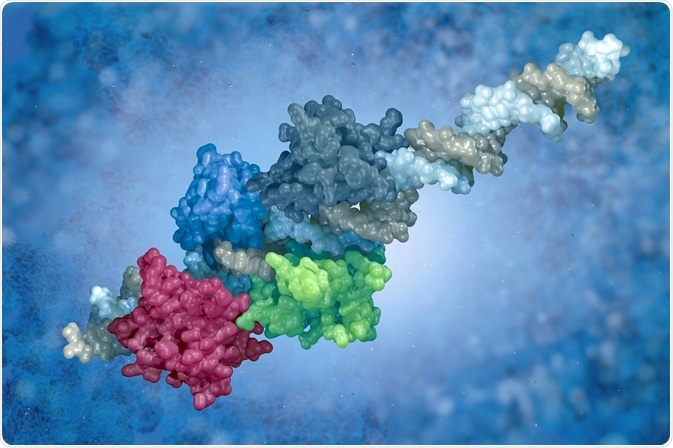By Jeyashree Sundaram, MBA
Single-molecule experiments (SMEs) have contributed various tools to the design of highly sensitive and precise scientific instruments. In particular, SMEs have been used to measure microscopic forces and visualize and manipulate each individual molecule.
 Credit: vitstudio/Shutterstock.com
Credit: vitstudio/Shutterstock.com
SMEs can be used for simultaneous manipulation of molecules and to discover molecular properties, characterize biomolecular reaction kinetics, and detect molecular intermediates. SMEs can also be used to define the thermodynamics of biomolecular processes.
Individual proteins such as living matter polymers (for example, microtubules or actin, RNA, DNA, and molecular motors) can be visualized as colloidal chains. The experimental manners by which SMEs can be understood beyond formalism are mentioned below.
Fluctuations of polymers
The molecular structure of a polymer can be visualized in various forms, and atomic details play a major role in this process. These details are important to determine the specificity of molecular interactions of different molecules. Mechanisms of transcription can be identified by analyzing transcription factor structure or visualization as a colloidal chain.
If single particles can be moved by kBT, then kBT may cause some shocks between the polymer and the medium. A deformation is caused locally within the colloidal chain, but the longitudinal extent is restricted by nearby colloids within the colloidal chain. There may be an appearance of local bent of finite lifetime, where opposite transverse direction forces are applied by other molecules in solvent. These events may happen again at lesser Reynolds number, and in the absence of inertia.
Such variations in shapes have been identified in a variety of single polymers such as actin filaments, DNA, and microtubules. Mostly, the thickness of biological polymers is in nanometer scale, which is almost less than 200 nm. Labeling of these biological polymers using fluorescent probes enables to identify them in fluorescent microscopy dynamics and their variation can be captured using CCD cameras.
Structure of biological macromolecules
There are various levels of organization in biological molecules. For instance, proteins are composed of amino acid sequences and then they get assembled into different domains. Proteins with different functions and localizations in cells of several different organisms can possess the same domains. These similarities are guides to probe and anticipate molecular interactions.
These domains contain binding sites that enable the recognition of protein—protein interactions. A protein domain will be illustrated as a schematic with parts, where each part performs a function that involves binding a site to a hydrolysis of adenosine tri-phosphate (ATP) or a protein partner.
Structures are essential to unravel the binding partners. These structures are augmented by dynamics that are used to find frequencies or times of macromolecule interactions.
Revealing dynamics of topoisomerases and their role
Topoisomerases are classified under enzymes that maintain the topological state of the DNA of cell. Though the biochemical, structural, and biophysical characters of these enzymes are well established, their dynamic interactionsremain mostly uncharacterized .
Previous SMEs have shown that an essential attribute of the type IA topoisomerase mechanism is the pauses that occur between relaxation events. Nevertheless, these trials could not delineate whether the protein remains bound to DNA during the time interval between the relaxation events.
A combination of two orthogonal single-molecule approaches indicate that conformational change constantly occurs in E. coli topoisomerase I when trying to change the DNA topology. Thus, its process can be explained as a sequence of DNA strand-passage assays that ends up in a successful relaxation event.
Interaction of DNA and photosensitive drugs
By connecting one end of a single λ-DNA molecule to the coverslip of a microscope to a polystyrene microsphere that is trapped by optical tweezers, it has been observed that the entropic elasticity of the λ-DNA can be calculated by extension versus force, as the molecule is stretched.
This approach is used to study the effects caused by photosensitive drugs on the DNA molecule elasticity. To study the different wavelengths that affect the linkage of DNA and photosensitive drugs, the sample is illuminated with various light sources.
Single Molecule Biophysics - Keir Neuman, NIH Scientist
Challenges of SMEs
It must be noted that performing these experiments is generally difficult and is highly time consuming due to the large number of trials required. Another major drawback in conducting these experiments is related to the success in single-molecule pulling with atomic force microscope, magnetic tweezers, or optical tweezers.
SMEs should be carried out in an appropriate incubated experimental chamber, because all DNA–protein interactions occur in a random manner. Proteins/DNA, tips, and beads are all incubated in this chamber, making manipulation difficult.
Though SMEs are difficult to perform, unbelievable results have been yielded by utilizing it in various biological researches.
Further Reading